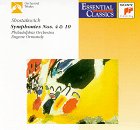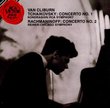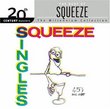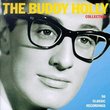| All Artists: Dmitry Shostakovich, Eugene Ormandy, Philadelphia Orchestra Title: Dmitri Shostakovich: Symphonies Nos. 4 & 10 Members Wishing: 0 Total Copies: 0 Label: Sony Release Date: 4/16/1996 Genre: Classical Styles: Historical Periods, Modern, 20th, & 21st Century, Symphonies Number of Discs: 2 SwapaCD Credits: 2 UPC: 074646240922 |
Search - Dmitry Shostakovich, Eugene Ormandy, Philadelphia Orchestra :: Dmitri Shostakovich: Symphonies Nos. 4 & 10
 | Dmitry Shostakovich, Eugene Ormandy, Philadelphia Orchestra Dmitri Shostakovich: Symphonies Nos. 4 & 10 Genre: Classical
The history of Shostakovich's Symphony No. 4 is now well known. It had been banned in 1935 by Stalin (who hadn't actually heard the piece) and surfaced 30 years later when Eugene Ormandy and the Philadelphia Orchestra reco... more » |
Larger Image |
CD DetailsSynopsis
Amazon.com The history of Shostakovich's Symphony No. 4 is now well known. It had been banned in 1935 by Stalin (who hadn't actually heard the piece) and surfaced 30 years later when Eugene Ormandy and the Philadelphia Orchestra recorded it (this is the analog transfer of that incredible first recording). It is a unwieldly work of broken rhythms and brash melodic statements. The coda, one of the most harrowing passages in all of 20th-century music, presages the Eighth Symphony and (years later) the Tenth. Ormandy's Fourth is the best on the market, and the Tenth is way up there as well. --Paul Cook Similarly Requested CDs
|
CD ReviewsThe first fourth is still the best Avrohom Leichtling | Monsey, NY | 08/03/2001 (5 out of 5 stars) "Eugene Ormandy, more than any other American conductor of his generation, had a special affinity for Shostakovich. His recording of the Fourth Symphony was made shortly after the world premiere some thirty years after it was written. That performance remains the best of the lot. Shostakovich is one composer whose music "plays itself" if you are intelligent enough to follow his directions. So many conductors labor under the delusion that they must make a piece of music "theirs." All too often, this means adding excessive amouts of 'interpretation' that only serves to distort or destroy the music. Ormandy was not immune to that syndrome, but, fortunately, it is not in evidence here. The Philadelphians give us a wonderful reading that is just right in all of its details. The phantasmagorica of this work needs no special emphasis - and that, clearly, is the genius of the composer. The later performance of the Tenth Symphony is also, just right. The tempi, phrasing and dynamics are on the mark (see the score, please), and there are no excesses of angst. Since it has become fashionable to view Shostakovich as the chronicler of opression and doom, it is also fashionable to play his scores as if our entrails were lying bloodied, on the floor. This tends to make the pieces much more hysterical than they are. His music deserves better. Ormandy serves his composer admirably in these performances primarily by not letting the emotional elements run amok. Here we have two primary exmaples of "less is more."Here is solid playing, and appropriate respect for the composer." The Fourth Fares Much Better In Ormandy's Hands jim collins | NY USA | 02/05/1999 (4 out of 5 stars) "To begin with the bad news, the Ormandy 10th suffers from a case of routine and a lack of energy in the playing. When one has heard the unstoppable drive of Mravinsky or the opulence of the Berliners under Von Karajan, this performance of the 10th bares little repeat listening. There are some breathtaking moments in the first movement, but little else of inspiration. The Fourth which Ormandy gave the American premere of, has every sense of the raw power that Kondrashin and Rozhdestvensky found. The Ormandy stiffness is there, and sometimes one would hope for a less restained brass section (Rozhdestvensky on the Russian Disc label) but there is great awe to be derived from this symphony. It is simply a revelation when one shudders as the final outburst of energy envelopes everything in the last movement before the mysterious ticking (also found in one of Katerina's arias in Lady Macbeth)of resignation itself slowly fades away. Since the Ormandy 10th is weak and the Kondrashin and the Rattle 4th is withdrawn (sob!) the Rozhdestvensky is the top choice right now. Still, this disc is a great introduction to Shostakovich's masterful symphonies." More magnificent than I remembered Charles Emmett | Oroville, California (the boonies) | 09/25/2002 (5 out of 5 stars) "I used to have an old lp recording of the fourth symphony with Ormandy and the PHO. But this copy that I got of the 4th and the 10th on cd are beyond description. I listen to all of my recordings with my earphones so I get all of the sounds and rythms very clearly.I had always realized Shostakovich's homage to Mahler, but I heard others as well and the way that Shostakovich weaves them all in along with his own distinct sounds works absolutely wonderful.For example, in the Fourth Symphony there was this unmistakable horn passage that no one could miss that was as if the horn had found the melody from Mahler's 7th Sym. and the 'song of the night tune' seems to be soaring out over the orchestra. To my surprise was Bartok and Stravinsky. I kept hearing passages similar to Bartok's 'Concerto for Orchestra' or his 'Orchestral Suites. And I swore that I was hearing little 'Rites of Spring' pop up hear and there. I am not saying that any of this was plageristic. I felt that it was all a sense of homage and so ingeniously inserted into his own music.This was my first experience of hearing the tenth. So awesome and beautiful, and again these periods of homage that were so beautifully inserted into the music and help to fulfill Shostakovich's ideas. I also loved the cyclic style of the 10th and how that idea from the first movement kept showing up in ever new and creative ways.Now for Ormandy and the PHO. Astounding! I have his recording of Shostakovich's fifth. I know that he recorded some others for RCA. I did once have no.13, 'Babi Yar', but have it no more. The brass was so clean and pure. The string section non pariel. as usual, was stunning in the fourth sym. and the 10th.
I would say that these recordings should be on any list for building an overall classical library, getting the true taste of non twelve-tone-row music that is considered contemporary and listen to the wonderful way the Shostakovich resolves some of the dissonances into wonderful tonic chords.Can someone at Amazon put some pressure on Sony and RCA to re-release all of his great recordings. I am always wonderfully surprised by the quality of sound by these thirty and forty and nearly fifty year old recordings." |

 Track Listings (4) - Disc #1
Track Listings (4) - Disc #1







